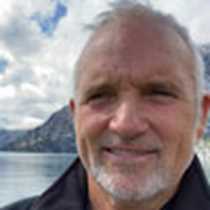Geology was front-and-center from the moment we awoke in the incredible landscape of Tracy Arm-Fords Terror Wilderness. In the wee hours before sunrise we crossed the bar, or more accurately, the end moraine of the glacier responsible for the fjord’s formation. By 6:00 a.m. we were well into the wilderness and seeing firsthand the effects of multiple periods of glaciation. Steep polished cliffs of granite rose from the water to heights exceeding four thousand feet and clearly showed us the erosive power of moving ice.
Our first off-ship activity began at 9:00 a.m. with Zodiac tours of the water directly below the ice-cliff terminus of South Sawyer Glacier. Using the nimble rubber boats we motored close (but not too close) to icebergs and bergy-bits, and we watched as harbor seals swam nearby or rested on the ice. Gulls, Arctic terns, and a few eagles flew near the ice cliff, occasionally diving to snatch a fish from the icy water. We spotted several mountain goats grazing on the steep slopes of the fjord.
The rock walls display many chapters of Earth’s history. They show complex cross-cutting relationships between magmatic intrusions of quartz, diabase, and the older metamorphic and granitic basement rock. The last chapter of the story is the uplift and dramatic sculpting of the land by repetitive cycles of glacial advance and retreat. The Pleistocene Ice Age left its mark on the landscape in the forms of towering horns, deep U-shaped valleys, cirques, scour, and glacial polish of the bedrock. Most importantly for us, that age is also responsible for the formation of the fjords in which we sail our ship.
It was a great way to start our exploration of Southeast Alaska.







